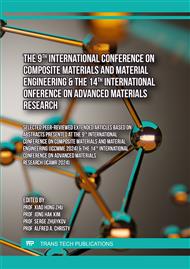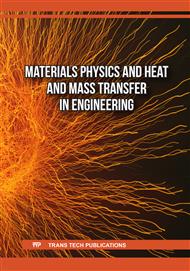[1]
R.K. Sharma, P. Ganesan, V.V. Tyagi, H.S.C. Metselaar and S.C. Sandaran: Developments in organic solid–liquid phase change materials and their applications in thermal energy storage. Energy Convers. Manag. Vol. 95 (2015), pp.193-228.
DOI: 10.1016/j.enconman.2015.01.084
Google Scholar
[2]
M.M. Farid, A.M. Khudhair, S.A.K. Razack and S. Al-Hallaj: A review on phase change energy storage: materials and applications. Energy Convers. Manag. Vol. 45 (2004), pp.1597-1615.
DOI: 10.1016/j.enconman.2003.09.015
Google Scholar
[3]
W. Gondora, K. Doudin, D.J. Nowakowski, B. Xiao, Y. Ding, T. Bridgwater, Q. Yuan: Encapsulation of phase change materials using rice-husk-char. Appl. Energy Vol. 182 (2016), pp.274-281.
DOI: 10.1016/j.apenergy.2016.08.102
Google Scholar
[4]
P. Sharma, V.K. Gaur, S. Gupta, S. Varjani, A. Pandey, E. Gnansounou, S. You, H.H. Ngo, and J.W. Wong: 2022. Trends in mitigation of industrial waste: Global health hazards, environmental implications and waste derived economy for environmental sustainability. Sci. Total Environ. Vol. 811 (2022), p.152357.
DOI: 10.1016/j.scitotenv.2021.152357
Google Scholar
[5]
P. Chaudhary, S. Garg, T. George, M. Shabin, S. Saha, S. Subodh and B. Sinha: Underreporting and open burning–the two largest challenges for sustainable waste management in India. Resour. Conserv. Recycl. Vol. 175 (2021), p.105865.
DOI: 10.1016/j.resconrec.2021.105865
Google Scholar
[6]
P. Liu, Z. Zhang, X. Gu, J. Rao, J. Shi, and L. Bian: Fabrication of a novel shape-stabilized composite phase change material based on multivariate supporting materials by using typical solid wastes. Constr Build Mater. Vol. 240 (2020), p.118156.
DOI: 10.1016/j.conbuildmat.2020.118156
Google Scholar
[7]
Y. Zhang, J. Wang, X. Yang, H.M. Ali, Z. Said and C. Liu: Fabrication of shape-stabilized phase change materials based on waste plastics for energy storage. J. Energy Storage Vol. 52 (2022), p.104973.
DOI: 10.1016/j.est.2022.104973
Google Scholar
[8]
J. Jiang, L. Lei, C. Jin, T. Liu, J. Huang, Y. Wu, S. Lv, Z. Lu, L. Zheng and J. Li: Preparation, microstructure, performance and mortar application of paraffin/titanium-bearing blast furnace slag phase change aggregate. Case Stud. Constr. Mater. Vol. 19 (2023), p. e02262.
DOI: 10.1016/j.cscm.2023.e02262
Google Scholar
[9]
Y. Konuklu, O. Ersoy and O. Gokce: Easy and industrially applicable impregnation process for preparation of diatomite-based phase change material nanocomposites for thermal energy storage. Appl. Therm. Eng. Vol. 91 (2015), pp.759-766.
DOI: 10.1016/j.applthermaleng.2015.08.040
Google Scholar
[10]
P. Uthaichotirat, P. Sukontasukkul, P. Jitsangiam, C. Suksiripattanapong, V. Sata, and P. Chindaprasirt: Thermal and sound properties of concrete mixed with high porous aggregates from manufacturing waste impregnated with phase change material. J. Build. Eng .Vol. 29 (2020), p.101111.
DOI: 10.1016/j.jobe.2019.101111
Google Scholar
[11]
L. Khanifah, S. Widodo, N.M.D. Putra, and A. Satrio: Characteristics of paraffin shielding of kartini reactor, Yogyakarta. ASEAN J. Sci. Technol. Dev. Vol. 35 (2018), pp.195-198.
DOI: 10.29037/ajstd.526
Google Scholar
[12]
B. Patel, P.K.S. Rathore, N.K. Gupta, B.S. Sikarwar, R.K. Sharma, R. Kumar and A.K. Pandey: Location optimization of phase change material for thermal energy storage in concrete block for development of energy efficient buildings. Renew. Energy Vol. 218 (2023), p.119306.
DOI: 10.1016/j.renene.2023.119306
Google Scholar
[13]
W.G. Alshaer, E. Palomo del Barrio, M.A. Rady, O.E. Adellatif and S.A. Nada: Analysis of the anomalous thermal properties of phase change materials based on paraffin wax and multi walls carbon nanotubes. Int. J. on Heat and Mass Transfer, Theory and Applications Vol. 1 (2013), pp.297-307.
Google Scholar



